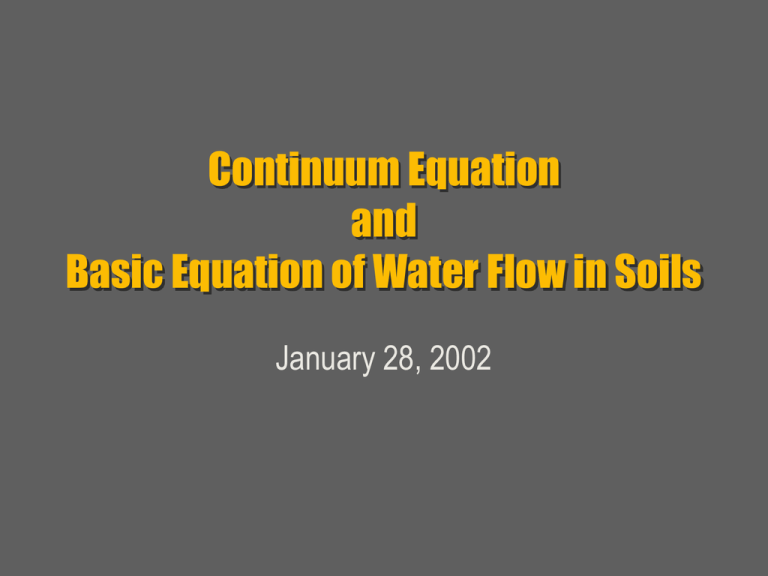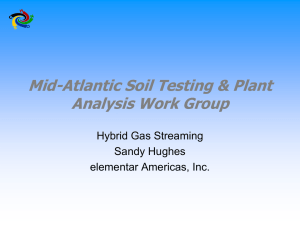Continuum Equation
advertisement

Continuum Equation and Basic Equation of Water Flow in Soils January 28, 2002 Elementary Volume - 1 Create a volume with imaginary boundaries within a pool of water (our fluid system) Call it “elementary volume” Elementary Volume - 2 What is the scale of elementary volume ? H2O Elementary Volume - 3 On molecular level, there are molecules and voids. Pick a point in the molecular volume, and your sample is H, O or void If we take a larger volume, chance is better that we get a sample of water “as a fluid” Each point in our Representative Elementary Volume (REV) should give us the same properties Representative Elementary Volume Volume large enough to be representative of the fluid (same properties everywhere) Small compared to the fluid system as a whole Can have any shape REV Assume simple shape: The Cube The Cube Imagine X-Y-Z axis Z z z X Y x y x y Describe volume of water flowing INTO cube z z x y x Q=q*A Qx = qx * y * z y Same for Qy and Qz inflow Qx = qx * y * z Qy = qy * x * z Qz = qz * x * y z z x y x y Describe volume of water flowing OUT of the cube z z x y y x Q = q * A + Change in flow Qx = qx * y * z + ( q x x * x )* y * z Outflow in 3 directions gives: Qx = qx * y * z + ( Qy = qy * x * z + ( Qz = qz * x * y + ( q x x q y y q z z * x ) * y * z * y ) * x * z * z ) * x * y Mass Balance All that flows in must flow out, except for the storage within the volume Or: In Out S Mass Balance Assumptions Water is incompressible No compression of water and storage in our “elemental volume” No sources or sinks in our “elemental volume” Steady State (no changes over time) Water flowing in equals water flowing out Thus: In Out 0 All Inflow: Qx = qx * y * z Qy = qy * x * z Qz = qz * x * y In (qx * y * z) + (qy * x * z) + (qz * x * y) Out qx * y * z + ( q x x * x ) * y * z + qy * x * z + ( q y y * y ) * x * z + qz * x * y + ( q z z * z ) * x * y In Out 0 (qx * y * z) + (qy * x * z) + (qz * x * y) qx * y * z + ( q x x * x ) * y * z qy * x * z + ( q y y * y ) * x * z qz * x * y + ( q z z * z ) * x * y -( q x x * x ) * y * z -( q y y * y ) * x * z -( q z z * z ) * x * y = 0 q x q y qz 0 x y z OR q x x q y y q z z 0 Now consider when S 0 For example, our REV is a cube of soil where the change in volumetric water content (q) during time (t) is q t Rate of gain (or loss) of water by our REV of soil is the rate of change in volumetric water content multiplied by the volume of our REV: q S * xyz ) t Thus: In Out S Becomes: In Out q t * xyz ) Proceeding as before we obtain: -( q x x * x ) * y * z -( q y y * y ) * x * z -( q z z * z ) * x * y = q * xyz t “Continuity Equation of water” q x q y q z t x y z q 3-D form of Continuity Equation of water is : q t Where: q t q y q x q z x y z is the change in volumetric water content with time; qx, qy and qz are fluxes in the x, y and z directions, respectively. In shorthand mathematical notation: q .q t Where the symbol (del) is the Vector differential operator, representing the 3-D gradient in space. OR q t div q Where div is the scalar product of the del operator and a vector function called the divergence. Now apply Darcy’s law and substitute : qx Kx qy K qz Kz H x H y y H z Into the Continuity Equation, we get : q H H H K y Kx Kz t x x y y z z Basic Equation for Water Flow in Soils Food for Thought: Now that we have an expression for water flow involving hydraulic conductivity (K) and hydraulic head gradient (H), …. What about case with constant hydraulic conductivity, K? Flow in Saturated Zone! What about when K and H is a function of q and matric suction head? Flow in Unsaturated Zone! Food for Thought: An expression exists to define q in steady state… q x x q y y q z z 0






